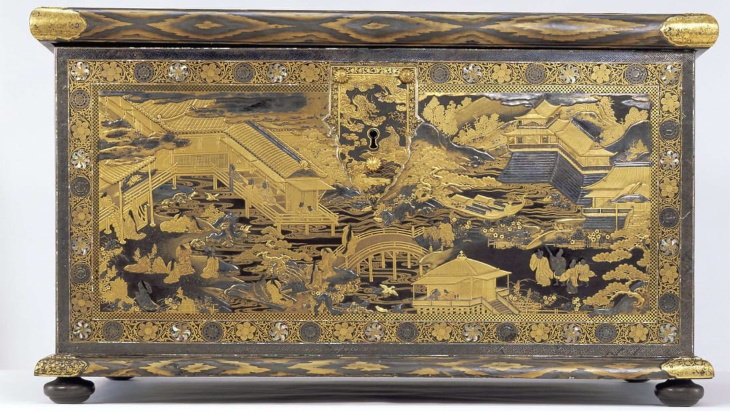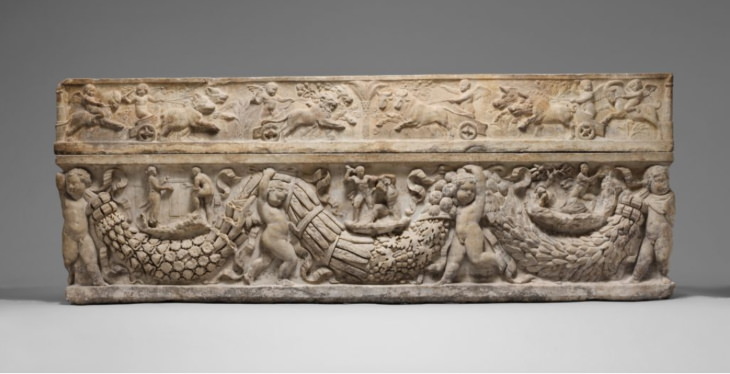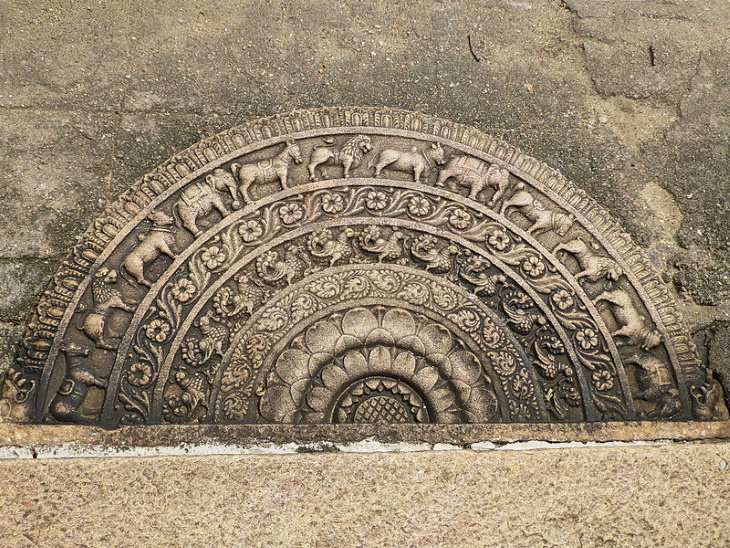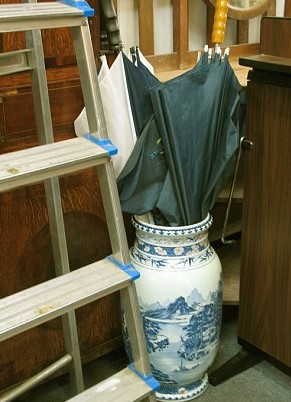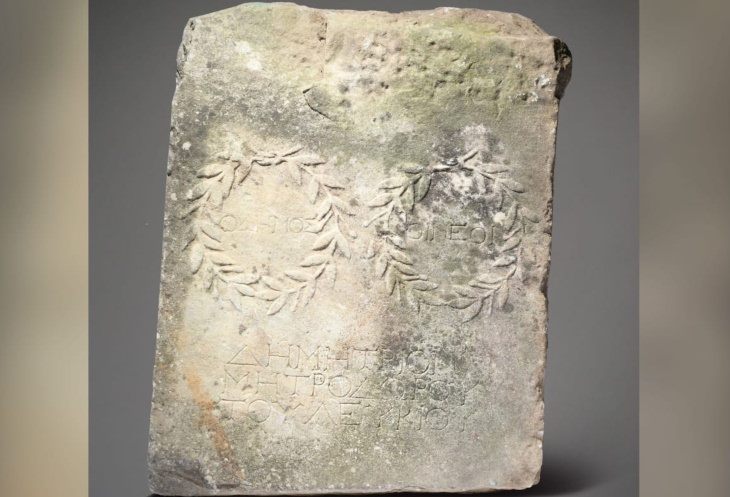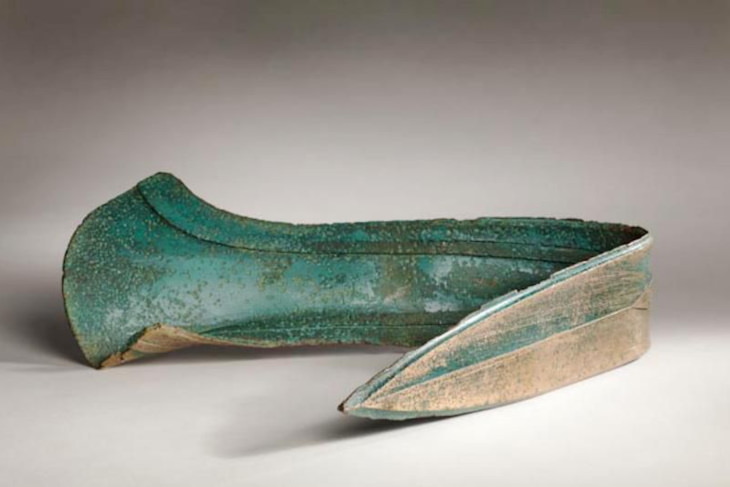1. The Mazarin Gold Chest served as a bar and TV stand
The famous Mazarin lacquer chest is a gold, silver, mother of pearl, and copper chest once belonging to the Chief Minister of the King of France, Cardinal Mazarin. The chest was hand-crafted by Kaomi Nagashige, the lacquer-maker of the Tokugawa shoguns in Kyoto circa 1640. The French Cardinal owned a set of two such chests and the beautiful lacquer masterpieces stayed in the family until the French Revolution.
William Beckford, a British novelist, and a famous art collector purchased the set of chests from the Mazarin family, and in 1882, the Victoria & Albert Museum acquired the smaller chest from Beckford. The fate of the larger chest, on the other hand, had been unknown for almost a century and the desperate attempts of the Victoria & Albert Museum to track down the historical artifact were fruitless.
The chest was thought to be lost forever, that is until the Mazarin chest suddenly re-emerged in 2013 when a family asked the Rouillac auction house to estimate their late relative’s estate in Touraine, France. It turns out that the chest was purchased by the late French engineer in London in 1970 for just £100. For years, the chest was used as a TV stand and a bar, and the owner was certainly completely unaware of the true price of the chest.
Mazarin's Lost Gold Chest was put on auction in 2013 and purchased by the Rijksmuseum for a mind-boggling sum of USD 9.5 million!
2. The Ancient Roman marble sarcophagus that served as a garden planter
Roman sarcophagi from the era were often heavily adorned
Using vintage-looking vases as garden planters isn't uncommon even today, but this tradition goes back to the 19th century when wealthy travelers would bring back genuine antique burial urns and sarcophagi and display them as garden accessories. Over time, the trend became so popular that cheap replicas of antiques started being produced for “the masses”, and even today, you can likely buy a clay antique-looking urn for $5 at the local garden supply store.
This explains why a family living in the small English town of Dorchester disregarded the old garden planter in their backyard for 100 years. In 2012, the house owners asked Guy Schwinge, of Duke's Auctions, to complete a routine evaluation of their property, and the hawk-eyed appraiser recognized a 2nd or 3rd-century Roman marble sarcophagus in the old moss-covered 7-foot garden planter.
The almost 2,000-year-old marble sarcophagus was most likely the tomb of a high-ranking Roman and it features beautifully-preserved ornaments, which make it a noteworthy find. Upon closer inspection of Duke’s records, Mr. Schwinge found papers proving that the sarcophagus was auctioned off in 1913 to the same address he found it, so the family must have simply forgotten the value of the Roman relic over the years.
The previous owner of the marble sarcophagus was Sir John Robinson, the first superintendent of the Victoria and Albert Museum, who had amassed quite the collection of artifacts throughout his life, of which the Roman sarcophagus was part. In 2012, the owners auctioned off the Roman sarcophagus at Duke’s for USD 133,000.
3. Rare Sri-Lankan moonstone being used as a garden paver
The Moon-stone found at the entrance of Uda Viharaya of Ridhi Vihara Sri Lanka Image Source: Reddit
Bronwyn Hickmott took a beautiful garden paver from her late parents’ home and installed it at her own home in Devon, England. In an interview with BBC, Bronwyn said she had been fascinated with the beautiful detailing and the curious shapes of the stone ever since she was a child, which is exactly why she decided to keep it.
Little did she know, the curious stone was one of the only seven existing Sri Lankan Sandakada Pahana, which are temple moonstones that date all the way back to the late Anuradhapura Period (10-11th century). The rare stone once stood at the entrance of the temple in Anuradhapura, the former capital of Sri Lanka and a sacred Buddhist city.
But how did this rare sacred artifact end up in England? Sam Tuke, the Bonhams appraiser who discovered the rare relic in Hickmott’s home, did some research and found that her late parents’ home in East Sussex once belonged to a tea planter who had lived in Ceylon, now Sri Lanka, in the 1920s. Although there is no record of him possessing the stone, Tuke believes he must have sneaked the Anuradhapura moonstone into England on one of his travels.
The Sandakada Pahana was purchased for a whopping USD 767,000 by an unknown buyer in 2013.
4. The ancient Imperial Chinese vase that worked as a decent umbrella holder
A retired couple from Dorset received a big blue and white vase as a gift half a century ago. They didn’t really like the vase and so they stashed it in a storage room and used it to hold umbrellas for 50 years. In 2010, our acquaintance from the sarcophagus story, Guy Schwinge from Duke’s, happened to be the appraiser to evaluate the house.
He stumbled upon the curious vase, and by that time, it was already stained and damaged as the owners had no idea of its true worth. To the elderly couple’s surprise, Schwinge claimed that the vase they hated was a one-of-a-kind Imperial vase from the Qing Dynasty made by the great porcelain master Tang Ying in around 1740. A seal on the bottom of the lantern vase confirmed that it once belonged to the Qianlong Emperor, and it is believed that the prized imperial vase was also owned by Florence Nightingale at one point in time.
In 2010, the Imperial vase was auctioned off for USD 867,400, and if it weren’t for the damage, the price would be twice the amount. We bet the owners were happy to finally rid themselves of the “ugly” vase, especially since it ended up costing more than their entire home.
5. The Ancient Roman marble that worked as a mounting block
Wouldn’t you be happy if the random rock you found in your yard would end up being worth thousands of dollars? This is exactly what happened to an unnamed woman from England, who found a marble slab in her garden and learned that it was 2nd-century Roman marble?
The woman had been using the rock for over 10 years in the stable to mount horses until she noticed the inscription "The people (and) the Young Men (honor) Demetrios (son) of Metrodoros (the son) of Leukios" in Latin and two laurel wreaths on the stone. After consulting an archaeologist, she found out that the marble piece is almost 2,000 years old and it came from Ancient Greece or Anatolia.
The exact origins of the marble are unknown, but it was likely another souvenir brought back by some wealthy Brits from their travels through Europe. In any case, the woman ended up getting USD 20,300 for the piece, a pretty penny for a “mounting block”, if you ask us.
6. The rarest and oldest door stopper in the world
One day, while plowing his field in Norfolk, England, a farmer stumbled upon a bent piece of bronze that looked like some kind of knife or sword. Without thinking too much about its origins, the practical man put it to work as a door stopper. For over a decade, the bronze piece served its new purpose, but the farmer soon became tired of it and wanted to throw it away.
Luckily for all of humanity and especially the farmer himself, a friend recommended he consult an archeologist before throwing the metal thing away, just in case. That metal thing ended up being a 3,500-year-old Bronze Age ceremonial dirk, one of only six like it in the world. In fact, the remaining five ceremonial daggers are so exceptionally similar to The Rudham Dirk, the one found by the farmer, that it is believed that they all come from the same workshop.
For those uninitiated in Bronze Age history, ceremonial weapons like this one were extremely valuable and expensive objects, bent intentionally for ritual purposes before it was buried. So, the prestigious ceremonial weapon was no junk, after all. In fact, the Norwich Castle Museum and Art Gallery purchased the farmer’s “door stopper” for a good round sum of USD 56,877.
Share these fascinating stories with others!

